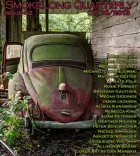There is the recurrent awareness the children have of their aloneness. It seems as if Nadija’s story heightens this awareness. Your choice of first person plural narrator makes it even more poignant for the reader. Was this intentional?
I don’t know if I can say it was intentional, at least not consciously, at least not at first. Conscious attention to point of view is not always something that’s on my mind when writing an initial draft; that type of thought might come later, during revision. All I knew when I was writing this was that first person plural felt right.
Now that you mention it, though, I’m sure there was some subconscious reason I was drawn to this particular point of view with this story. The collective American narrators speak as one entity but are acutely aware of their loneliness, while on the other hand, Nadija, who is not part of that collective narration and who is seemingly more “alone,” had been part of a collective spiritual experience in her native country, something the American narrators have never experienced. Perhaps, then, the point of view is a play on the sense that, in America, we are constantly surrounded by people, constantly “networking,” but somehow spiritually alone. And it’s that sense of a spiritual relationship that these American narrators envy. But, really, it’s probably less a cultural issue than a human one: the narrators view Nadija as somehow exempt from that basic existential aloneness that plagues them every night when they close their eyes and try to fall asleep. Whether or not she truly is exempt doesn’t matter—there is a longing, and almost a hope, that imagining her not-alone has inspired them with.
The children can imagine missing body parts and children firebombed, but the
rape of a grandmother seems too horrible to mention directly, instead referring to it as “someone’s grandmother bleeding between her legs years after her last menstruation.” This treatment somehow seems true, though. Was it a conscious decision?
Again, the indirectness of the reference to rape was not a conscious decision, but it’s definitely an interesting element to bring up. I think part of it might have to do with the narrators being female (though their gender is never explicitly stated), and their sensitivity to that particular type of violence. And isn’t it true that in most accounts of war, the violence and the death and the destruction are all front-page news, but the side-effects of war (the rapes and things of that nature) are not as directly dealt with? Perhaps that’s part of it as well (though, again, this is after-the-fact expostulating).
You were an assistant editor at Mid-American Review. How did that experience influence your own writing?
Working at Mid-American Review while I was getting my MFA at Bowling Green State University was such a great experience, and it shaped me as a writer in a lot of ways. By reading through the slush pile, I realized how important it is to really grab the reader from the first page, if not the first sentence, which is still not always something easy for me to accomplish, but something I strive for. Also, there was such a great affinity between my own aesthetic and the aesthetic of the journal as well as many of the other assistant editors at the time, which was amazing—but what I noticed was that there were sometimes stories coming in through the slush pile that had similarities to my own work, whether in style or concept or aesthetic. Those stories served as lessons on what to do or what not to do, depending, and they helped me to realize that I have to try to carve out my own unique voice as best I can. Of course, I also learned the lesson that sometimes a story can be well-crafted and “good” but just, truly, “not the right fit” or “not right for us at this time,” which helped me to put my own rejection letters in perspective. Finally, Mid-American Review published so many amazing stories and authors during the time I was there, that I harbor the hope that by reading those stories my own writing was able to absorb, osmosis-like, maybe the tiniest fraction of their greatness.
Can you tell us about your writing process?
I wish I was one of those people who say, “Every single day I get up at 5 a.m. and write for three hours until I go to work…” but unfortunately (probably just due to my own laziness) I’ve never really been able to carve out a perfect writing schedule. I currently teach full time, and before that I was an adjunct teaching a more-than-full load between two colleges, and I’ve always found it difficult to balance teaching and writing during the semester. It’s not that I don’t have the motivation or inspiration to write, but I think it has to do with the fact that I am the type of person who throws myself completely into whatever task I’m doing, and everything else suffers for it. So during the semesters, I devote myself almost entirely to teaching (sometimes squeezing in writing on random weekend afternoons or mornings if I have a late class, but mostly collecting scraps of ideas in notebooks), and during breaks I am finally able to devote myself almost entirely to writing. This past summer was the first time in years that I actually did not have to teach, and I can’t even begin to explain how wonderful it was to have such a long stretch of time to just write. During this summer, I spent long hours in the morning and in the afternoon, devoting the whole day to writing. It was during this past summer that I finished the project that this story is a part of.
Different stories come from different places, for me. Many times, there is an image that has stuck with me; or a phrase; or a memory loosened from the context of my life; or a connection between two disparate events; whatever it is, a story begins with a single thread that is then braided with other threads, and hopefully by the end the fabric of the story emerges. This particular story was partially inspired by some research I was doing about the real-life children of Medjugorje, who claimed to have visions of the Virgin Mary.
What are you reading at the moment?
I’m currently reading A Questionable Shape by Bennett Sims, published by the great indie press Two Dollar Radio. It’s a book about zombies and memory—definitely up my alley, as I am an equal fan of both The Walking Dead and Proust.


